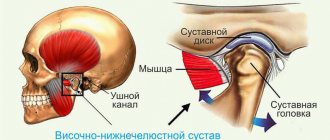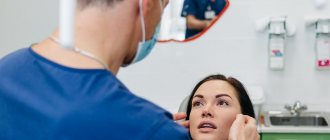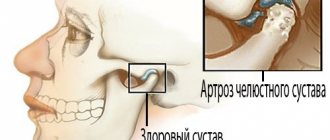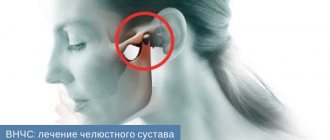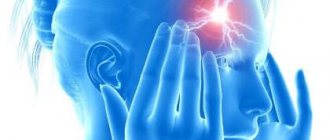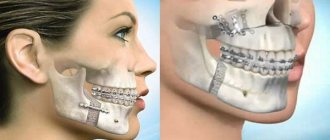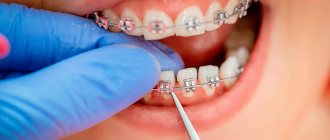What patients may complain about with diseases of the temporomandibular joint or TMJ
Clicking, crunching near the ear, namely in the projection of the temporomandibular joint (TMJ), pain in the jaw, jamming of the jaw when opening the mouth - all these are symptoms of muscular-articular dysfunction.
To find out the cause of this dysfunction, you first need to know how the joint works.
- Joint capsule
- Articular head or condyle
- Articular disc
- Articular tubercle
Where does everything come from?
Clicking is characteristic of dislocations of the articular disc, which can be anterior, posterior and lateral. The picture below shows from left to right: normal disc position, posterior dislocation, anterior dislocation. Dislocation occurs with or without reduction, i.e. with and without reduction. So, with a dislocation with reduction, you can hear two clicks: the first at the moment of opening the mouth, the second at the moment of closing.
What are the dangers of clicking in a joint? The danger lies in premature wear of the joint elements, which will lead to the development of arthritis, arthrosis and the final stage - ankylosis (complete immobility of the joint).
As for the crunching sound in the joint when the jaw moves, this sound is more characteristic of arthrosis of the TMJ. It occurs as a result of friction of deformed surfaces. The outcome of arthrosis is ankylosis or complete immobility of the joint.
Pain syndrome may often accompany TMJ arthritis, and in the projection of the joint, i.e. in front of the ear tragus there is swelling, skin hyperemia, general malaise, increased body temperature, etc. Arthritis pain is acute. Purulent inflammation in a joint can result in complete destruction of all its elements.
Also, acute pain can accompany neuralgia, anterior dislocation of the articular disc, in which the posterior condylar fusion ruptures and compression of the articular disc occurs. Dull, aching pain can occur with arthrosis, chronic arthritis and TMJ pain dysfunction syndrome (TMD).
With the development of BSD, in addition to pain in the joint area, headaches, pain and noise in the ears, and muscle tension in the occipital region are also possible.
Patients complain of difficulty opening the mouth (jaw contracture) mainly with arthrosis and sometimes with BSD. The process of jaw jamming is a different problem, and should not be confused with jaw contracture. The mechanism of wedging refers to the dislocation of the articular disc, which was discussed above. Without going into details, this can be explained this way: the articular head, under certain circumstances, does not return to its original position, because cannot overcome, for example, the posterior pole of the disc if it was in a state of dislocation. Or we are talking about dislocation of the lower jaw, when the articular head, when opening the mouth very wide, moves forward from the articular tubercle.
Distinctive features
Complaints in diseases of the TMJ should be distinguished from many other pathological processes in this area. So next to the TMJ there are: the auditory canal, the parotid salivary gland, the masticatory muscle, lymph nodes, and the corresponding pathological processes: otitis media, sialadenitis, myositis, lymphadenitis. In addition, pain can be due to neuralgia and inflammatory diseases in the skin and subcutaneous tissue (for example, with a boil). Separately, it is necessary to consider tumors of the parotid-masticatory region, benign and malignant.
As for the pathology of the oral cavity, in the form of difficult eruption of wisdom teeth or complicated dental caries, the main problem they create is limited opening of the mouth (contracture), which occurs as a result of the transfer of inflammation to the masticatory muscles. The pain in this case may also be similar, because impulses from the teeth spread along the branches of the trigeminal nerve, and the pain can radiate to the ear and temple.
Which doctor can help?
The dentist deals with this problem. The area of activity may be as follows: orthopedics, orthodontics or surgery; The main thing is that the doctor specializes in the diagnosis and treatment of TMJ pathology. Currently, such specialists are usually called gnathologists.
What if my dentist finds it difficult to make a diagnosis?
And this can happen. It is necessary to consult with related specialists: ENT doctor, neurologist, maxillofacial surgeon. If these specialists rule out their pathology, then there is only one option left. What's next? See previous paragraph.
What examination is necessary to diagnose TMJ pathology?
Unfortunately, based on complaints alone, a diagnosis cannot be made and, accordingly, treatment cannot be prescribed. An examination and sometimes additional studies are required: X-ray examination, computed tomography, electromyography, recording of movements of the lower jaw, etc.
Establishing the causes of the disease can be helped by collecting anamnesis: previous injury, any treatment (especially dental), the presence of diseases of internal organs and body systems, etc.
What can you do yourself?
If TMJ is still suspected, then the only thing you can do to help yourself is to create rest for the joint. That is, exclude solid foods, exclude chewing gum, do not open your mouth wide and do not yawn. If there is severe pain, when it is not possible to visit a doctor and there are no contraindications, use analgesics.
For complete treatment of TMJ diseases, see specialized literature.
Classification of pathology
Depending on the method of infection, the following types are distinguished:
- Hematogenous - bacteria spread through the circulatory system from other infectious foci. This path is typical for secondary osteomyelitis of the upper jaw, which develops against the background of another disease. This could be scarlet fever, purulent otitis media, tonsillitis, or diseases of the larynx. First, the infection affects the bone tissue of the jaw, and then only the teeth and gums.
- Odontogenic – external route of infection. The cause is an infected pulp or tooth root. Predisposing factors include advanced dental diseases. These are pulpitis, periodontitis, the presence of cystic formations, alveolitis.
- Traumatic – fractures and injuries of the jaw joint with damage to soft tissues and the presence of fragments of the dentition. Often occurs due to late seeking medical help.
According to the course and nature of the manifestation of symptoms, the pathology can be acute, subacute and chronic. Based on the area of distribution, local (limited) and diffuse (diffuse) forms are distinguished.
Possible causes of pain
Most often, the joints of the jaw hurt because the muscle fibers are strained and anatomical changes occur in the joint unit. The situation is aggravated by psychological reasons, sleep disorders, and emotional stress. In addition, provoking factors include:
- Bruxism, that is, grinding of crowns;
- Osteopenic disorders of the body;
- Genetic bone pathologies;
- The jaw joint near the ear hurts when an infection develops, the patient has suffered a neck or head injury;
- Muscle pain, internal disorders, tension;
- Ankylosis, arthritis, excessive mobility;
- Lack of chewing organs, unprofessional orthodontic treatment;
- Active conversation load;
- Pain in the jaw joint and radiates to the ear in patients with the habit of biting nails or placing the smartphone close to the hearing organ;
- Problems of the central nervous system, scoliosis and osteochondrosis of the spine;
- Pathologies of the endocrine system;
In addition, dysfunction occurs with asynchronous movements of the joints on both sides.
Pain in the jaw joint: causes
- Defects in the dentition - lack of teeth, overestimation of fillings;
Pathological abrasion of teeth;- Broken bite
;
- Overload of the masticatory muscles (for example, if you chew on only one side for a long time);
- Inaccurate prosthetics, errors in orthodontic treatment;
- Other anomalies of the oral cavity and jaw structure;
- Bruxism, involuntary grinding of teeth.
- Birth trauma, trauma to the skull and jaw;
- Osteochondrosis and scoliosis of the spine;
- Severe constant stress
;
- An infection in the joint cavity that provokes inflammation of the TMJ.
Who is susceptible to bruxism
The disease is often considered characteristic of people who are overly busy and busy, and is attributed to great psycho-emotional stress and stress in everyday life. This is not always the case - even adequately busy people can suffer from bruxism.
According to a survey of those seeking psychological help and concerned about bruxism, such patients do feel tension during the day. However, the level of this tension is quite optimal and necessary for most often performing intellectual work. Many clients have an optimistic character, but there is still a tendency towards workaholism. Most often, grinding at night was found in closed and secretive people who strive to keep all experiences and emotions to themselves (both positive and negative).
Also, according to observations, bruxism manifests itself in people with a strong sexual constitution, who do not always manage to fully realize their sexual potential. Probably, the accumulated tension could become a trigger for the manifestation of bruxism, as a release of energy at night due to unsatisfied activity. Because on the lips, which are related to the dental system, there are a huge number of sensitive areas.
Another hypothesis is that teeth grinding and jaw clenching can accompany patient people who keep all their passions, tears, resentments, anger and irritation within themselves due to their nature or lack of ability to express negative emotions. Anxiety, the presence of neurosis, unresolved internal contradictions and complexes can also cause the development of bruxism. Hippocrates also believed that “confusion of the soul is the main cause of teeth grinding.”
Strong-willed people, trying to gather strength and overcome fears, are subject to strong jaw clenching. A highly developed instinct of self-preservation also plays an important role here. The clenching of the jaws and teeth resembles an element of struggle or a defensive reaction, proving that the person is still alive.
Thus, the reasons for the persistence of bruxism may vary depending, including on age .
- For children, these may be protest reactions to the prohibitions or behavior of adults, parental divorce, moving, changing kindergarten or school;
- in adolescents - rebellion, suppression of anger and the desire to escape from the care of elders, uncertainty with the choice of profession or incorrect self-determination.
Which doctor should I go to?
In order to properly treat pain in the jaw joint when opening the mouth, it is necessary to develop an optimal treatment regimen. This can be done by a professional orthodontist.
- If the patient needs to have braces, plates, dentures, or implants installed, impressions of the teeth are taken. Complex therapy for TMJ gives good results.
- In serious cases, surgical technologies are used - bone and muscle grafting. The pathology cannot be neglected so that it does not develop into arthrosis with the proliferation of connective tissue and subsequent immobilization of the joint. It is important to eliminate the root cause of the disease.
- Severe spasms and discomfort are relieved with compresses.
- For stress that leads to tension, the patient is prescribed sedatives.
- Sometimes splinting is required.
- The patient may be recommended physical therapy.
- Patients may be prescribed nonsteroidal drugs, muscle relaxants, and sedatives.
Therapy also includes eliminating defects in the masticatory organs, grinding fillings, correcting prosthetic errors, replacing structures, and correcting bites. The load on the joint must be reduced. To do this, you should include soft foods in your diet, perform relaxation exercises and massage complexes. Ultrasound and laser therapy may be required. It is easier to eliminate the disease at the initial stage so that it does not become chronic. Timely visits to the doctor, correction of posture, elimination of stressful situations, replacement of lost units are effective preventive measures.
Diagnostics
Diagnosing TMJ disorders first involves taking a medical history, followed by a physical examination. The doctor applies light pressure on the side of the face where there is discomfort, on the masticatory muscle fibers. At the same time, the patient closes and opens his mouth. Popping or clicking sounds and jaw thrusting are analyzed. If indicated, an MRI may be prescribed. The procedure will show whether there are internal problems with the joint. If osteoarthritis is suspected, x-rays and CT scans can confirm the diagnosis.
Pain in the jaw joint when chewing and opening the mouth often occurs with infectious arthritis. Diagnosis is made by inserting a needle into the joint itself to collect fluid. This research method is called aspiration. The liquid is analyzed for the presence of pathogenic bacteria. Hypermobility and ankylosis are determined by the width of the mouth opening. Sometimes the patient is referred for polysomnography to determine sleep disorders. An orthopantomogram of the jaw plays an important role in the research process.
Diagnostics and x-ray of the temporomandibular joint
Diagnosis of TMJ when it is dysfunctional is difficult due to the variety of clinical complaints. This leads to the fact that the patient can undergo examination by different specialists for a long time, wasting time. A full examination is carried out by dentists
(primarily an orthopedist or orthodontist) and neurologists.
Diagnosis with the naked eye is difficult, and TMJ problems can only be directly noticed if the malocclusion is clearly visible. Most often, dysfunction of the temporomandibular joint is associated precisely with disorders of bite and jaw closure.
The most reliable and effective way is to conduct x-ray diagnostics and orthopantomogram
jaws. In some cases, an MRI may also be done.
